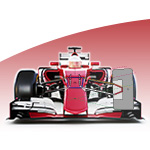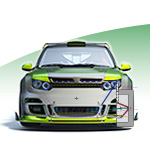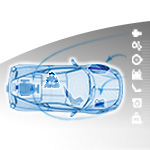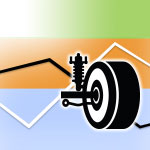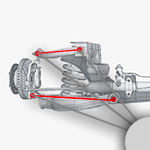Unsprung Weight

Extra
We have all know heard that reducing un-sprung weight is the the single most effective way of improving your cars handling, right? I think we’re on the same page, but let’s look deeper into how reducing unsprung weight may help…
First, let’s look at the springs and shocks. If you have read the wheel frequency article you will know that CPM is the frequency at which the spring oscillates (the wavelength). The amplitude is the intensity of the wave. On hitting a bump, the spring will react by oscillating at the CPM – the amplitude of the oscillations will reduce over time until the spring once again dormant. The purpose of the shock is to reduce the amount of time it takes for the spring to reduce its dormant state as, then the spring is fully ready to react to the next bump.
 |
Simply put:
|
Reactions from the Internet
“If the wheels (and other unsprung bits) have less inertia, the suspension reacts faster to bumps meaning the wheels stay in contact with the road better. ” – https://www.pistonheads.com/gassing/topic.asp?h=0&f=23&t=591832
“By reducing this, you can reduce the damping forces needed, making the shocks more sensitive, and reduce the need for such tight seals, which reduced friction/stiction. ” – https://www.pistonheads.com/gassing/topic.asp?h=0&f=23&t=591832
“In general, it’s best to have a high ratio of sprung-to-unsprung weight. A higher proportion of sprung weight can then push down on the wheels and tires with more force, keeping them in contact with the pavement or whatever surface they are traveling across. Maintaining contact with the roadway improves handling and traction, and this becomes more of an issue for off-roading and traveling over rough roads.” – http://www.machinedesign.com/springs/what-are-differences-between-sprung-and-unsprung-weight
“Reducing unsprung weight is the key to improving handling. The lower the unsprung weight, the less work the shocks and springs have to do to keep the tires in contact with the road over bumpy surfaces. Lot of problems, if not all of them is caused by inertia. Bigger weight means higher inertia. Higher inertia means more workload for shocks and springs to keep tiers on the ground. If unsprung components have a high mass they are harder to accelerate/decelerate and thus it is more difficult for the suspension to maintain a consistent tire load. ” – http://www.formula1-dictionary.net/unsprung_weight.html
Subscribe
You may find the wheel frequency calculator and weight distribution calculator useful during your pursuit of less unsprung weight.
to the Wheel Frequency Calculator |
to the Weight Distribution Calculator |





